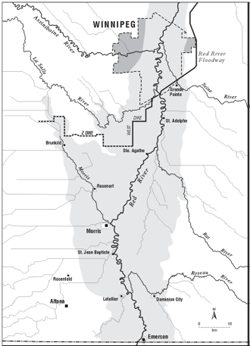Historic Flood - 1826
An excerpt from Some observations on peak stages during the 1826 Red River flood and the “Fleming Conundrum” (Prairie Perspectives, Vol. 6, WF Rannie, University of Winnipeg) The 1826 flood was the largest known in the Red River Valley, with an estimated peak discharge about 40 per cent greater than the natural flow in the 1997 flood. The conditions that caused the 1826 flood have been described in detail by St. George and Rannie (2003). The event devastated the struggling Red River Settlement, led to the exodus of German and des Meurons regiment settlers, precipitated the relocation of the Hudson’s Bay Company headquarters from Upper Fort Garry (in present-day Winnipeg) to flood-free Lower Fort Garry (near Selkirk, 40 kilometres downstream). It also figured prominently in the 1870s debate about the location of the railway crossing of the Red River. Moreover, the flood had effects that reached beyond its importance in the early history of the Winnipeg region. Indeed, it can be speculated that without the example of the severe flood threat 1826 provided, a lower, more common, and less expensive standard might have been adopted for the flood protection system for Winnipeg after 1950. Had that been the case, it is unlikely that Winnipeg would have escaped major damage from the 1997 flood. |
 Generalized extent of 1826 flood in Manitoba (WF Rannie) |
Articles on the flood of 1826:
- “Some observations on peak stages during the 1826 Red River flood and the ‘Fleming Conundrum’” (Prairie Perspectives, 6, WF Rannie, University of Winnipeg)
- “The Causes, Progression and Magnitude of the 1826 Red River Flood In Manitoba” (S St. George, B Rannie, Canadian Water Resources Journal, 2003)
- “Red River Flood – 1826” (Manitoba Pageant, Spring 1966, Volume 11, Number 3)
- “The role of the Assiniboine River in the 1826 and 1852 Red River flood” (Prairie Perspectives, Vol 5, WF Rannie, University of Winnipeg)


